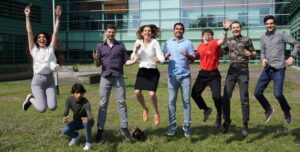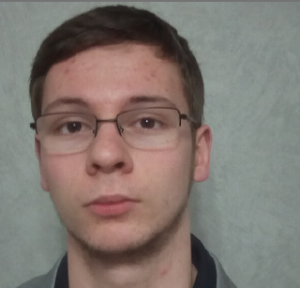Science is really a team effort. The people below are collaborating with me on different Projects.

I am always looking for new people to join my lab. For current open internship projects, see this page. Since we do mostly modelling, computer simulations and advanced data analysis (that means, bluntly said, computer programming and mathematics), some affinity and experience with math and programming would really help (see here for an overview). If you’re motivated and willing to learn, you don’t have to be an expert of course, but especially for short internships it is better to be able to focus on the science than on learning how to program.
NB There are several programs you can follow if you want to go into (computational) neuroscience. This is a list of all the Neuro-based MSc programs in Nijmegen. From September 2026, a new BSc program in neuroscience will start!
These are good resources to start looking for jobs in Computational Neuroscience!
BSc
MSc
| Daniel Bijker explores the effect of synaptic heterogeneity on network dynamics and learning tasks, using the FORCE training approach on rate neural networks. |
PhD
| Max Rense is a DBI2 PhD candidate, making predictive processing models of the auditory cortex | |
 |
Nishant Joshi is a SmartNets PhD candidate, modelling the effect of single-neuron non-linearities on network behaviour. |
 |
Tousif Jamal is a SmartNets PhD candidate, analysing network patterns in molecular and neural networks |
 |
Nicolas Rault is a SmartNets PhD candidate, developing network models of somatosensory processing. |
|
Tea Tompos is implementing biophysical principles of intracellular information processing in neuromorphic software and later hardware. |
|
 |
Filip Novický is a Serotonin and Beyond PhD candidate, modelling the effects of serotonin and its relation to attention. |
Postdoc
 |
Arezoo Alizadeh is a Vidi postdoc, modelling the effects of neuromodulators in balanced networks. |
| Farhad Razi is a Vidi postdoc, modelling the effects of neuromodulators on FORCE learning | |
| Stefan Iacob is a Vidi postdoc, modelling the effects of neuromodulators on spike coding networks |
Alumni
Filip Novický was a Serotonin and Beyond PhD candidate, modelling the effects of serotonin and its relation to attention. He graduated in 2025.
Utku Ortal explored the relation between network dimensionality, trial to trial variability and representation error in spike coding networks
Daria Mihăilă was an ELLIS excellence fellow, investigating the effects of neural heterogeneity on balanced networks
Leo Tinius analytically researched the effects of the E-I ratio in balanced networks on the network activity
Mariami Truchian analyzed in vitro single cell data
Eva O’Donohoe is analyzed the effects of delay on information transfer in hippocampal circuits
Parineeta Ekhande analyzed the effects of delay on information transfer in hippocampal circuits
Ildefonso Ferreira Pica modelled the effect of dopamine on the balanced state in networks of barrel cortex.
Lino Vliex integrated biologically realistic models of barrel and motor cortex, in order to evaluate the quality of whisker-related information processing. This to answer the question to what extend motor and sensory information are optimally integrated in (active) sensing tasks.
Axel van Emmerik used advanced mutual information methods to research proteomic networks
Irene Tiemeijer modelled biophysically realistic models of barrel cortex
Joris Bottelier used ‘FORCE’ learning to study recurrent neural networks that can learn to perform tasks.
Camille de Keijser analyzed in vitro single cell data
Thijs van Loo used ‘FORCE’ learning to study recurrent neural networks that can learn to perform tasks.
Lauren Keizer modelled microcircuits of barrel cortex.
Angeliki Sideri measured the information transfer of inhibitory-excitatory microcircuits.
Anna Chita is modelling the effects of deprivation on barrel cortical circuits
Raimon Bullich I Vilarrubias researched the effects of acetylcholine on heterogeneous spike coding networks in a joint project with Sander Keemink
Mark Bensman modelled microcircuits of barrel cortex.
Saskia Okkerman investigated how the method to measure information transfer depends on the number of excitatory and inhibitory neurons
Pedro Alonso Gonzáles investigated the differences between threshold adaptation and spike frequency adaptation on information transfer.
Lois de Groot used ‘FORCE’ learning to make recurrent neural networks that can learn to perform tasks.
Mik Schutte updated the method to measure information transfer in vitro to dynamic clamp
Joost van Tiel analyzed the data Linda Wouter modelled in the plasticity after whisker deprivation in barrel cortex project.
Vaishnavi V used‘FORCE’ learning to make recurrent neural networks that can learn to perform tasks.
Additaya Sharma is modelled the balanced states in networks of barrel cortex.
Hendrik Scheeres is used ‘FORCE’ learning to make recurrent neural networks that can learn to perform tasks.
Tim Winter was integrating biophysical simulation models on the one hand, and phenomenological models, using ‘FORCE’ learning to make recurrent neural networks that can learn to perform tasks.
Xenia Sterl was modelling the effect of dopamine on microcircuits of barrel cortex.
Niccolò Calcini developed a new method for analysing calcium data and did in-vitro experiments to measure the information transfer in excitatory and inhibitory neurons.
Prescilla Uijtewaal modelled balanded networks in a joint project with Bernhard Englitz.
Mihaela Neacsu did a short summer internshop on measuring the information transfer of inhibitory-excitatory microcircuits.
Ate Bijlsma developed single-neuron models to explain his recordings.
Sam Verhezen measured the information transfer of inhibitory-excitatory microcircuits.
Dimitris Chatzakis compared different methods to measure information transfer, and how that depends on neuron type during his Erasmus internship.
Eva Koenders modelled the VC data Ate Bijlsma recorded, in order to investigate the threshold behaviour in barrel cortical neurons.
Linda Wouters modelled plasticity after whisker deprivation in barrel cortex.
Thijs Groenveld has analysed a dataset from Janelia farm to validate our model.
Charlee Fletterman has compared models of predictive coding.
Isolde Kuijper has investigated the effects of adaptation and non-linear processing on optimal coding in single neurons.
Jiri Brummer has investigated biologically realistic balanced networks.
Pantelis Leptourgos has researched Bayesian detection in single neurons.
Stefan Bucher has fitted GLM models to hippocampal in vitro data.
Laura van Heerden has modelled the high-conductance state in thalamocortical relay neurons.
Arjan Groen has calculated the reliability of spike trains in models of CA3 of hippocampus.
Lisanne Huurdeman has analysed in-vitro data of thalamocortical relay cells.